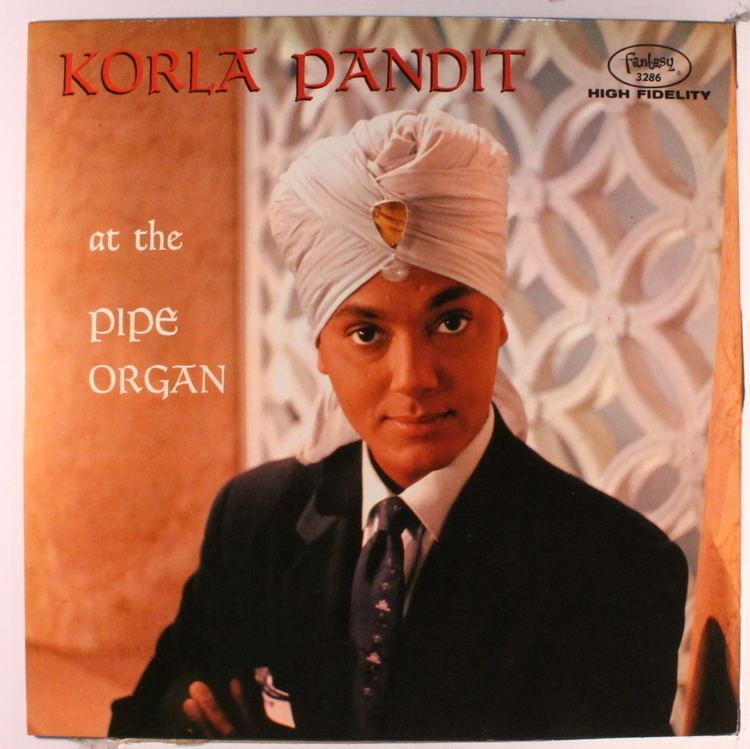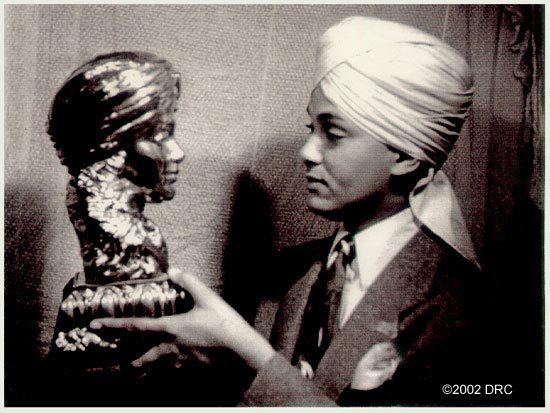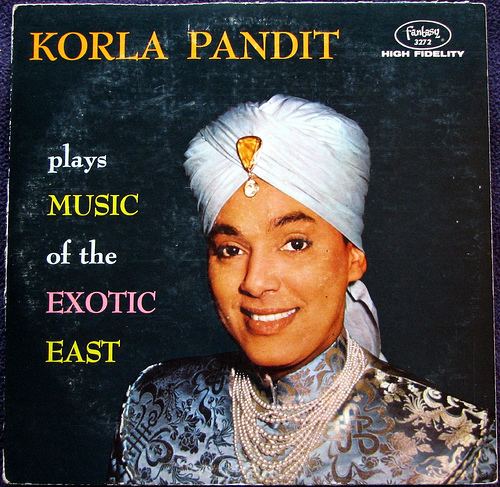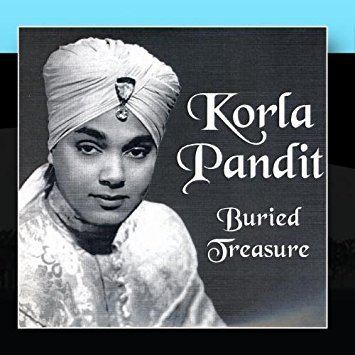Name Korla Pandit Role Musician | Movies Ed Wood, Which Way Is Up? | |
 | ||
Spouse Beryl DeBeeson Pandit (m. 1944–1998) Parents Doshia O'Nina Johnson Redd, Ernest S. Redd Similar People Liberace, Roger Williams, Edie Adams, Fred Waring, Walter Brennan | ||
Korla pandit
Korla Pandit (September 16, 1921 – October 2, 1998), born John Roland Redd, was a musician, composer, pianist, organist and television pioneer of national notability. Known as the Godfather of Exotica, he claimed to be French-Indian and from New Delhi, but he was actually "one of the first African-American television stars."
Contents
- Korla pandit
- Korla pandit music of the exotic east 1958 complete
- Family education and early career
- Los Angeles Hollywood and Korla Pandit
- Television
- Recordings
- Death and revelations
- Filmography
- Listen to
- References

Raised in small towns in Missouri, Redd created a decades-long career from the 1950s through the 1990s in Los Angeles passing as a French-Indian musician known as "Korla Pandit". In the 1940s, Redd had earlier performed in Los Angeles under the stage name of "Juan Rolando", in order to be admitted to the whites-only musicians union and get more work. While many African-American colleagues knew of his impersonation as Pandit, no one revealed it during his lifetime.

Korla pandit music of the exotic east 1958 complete
Family, education and early career

In 1921, John Roland Redd was born in St. Louis, Missouri, as the sixth of seven children in an African-American family. His father Ernest Redd was a Baptist pastor and also worked in his career in the YMCA. A contemporary photo suggests that he had European-American as well as African ancestry. (See External links below). His mother Doshia O'Nina Johnson had French, English, and African ancestry. Both parents were also descended from slaves. Redd, his two brothers, and four sisters, were all light-skinned with straight, glossy hair, and were ethnically ambiguous in appearance. Their mother's paternal grandfather was Henri Jeansonne, born in Lyon, France, who immigrated to the United States. He married Marie Le Cleur, a woman of color who was a Louisiana Creole (meaning mixed race) in New Orleans. Their son Henry F. Johnson, b. 1863, used or was given an anglicized surname. Doshia's maternal grandfather's line of Lankford (also spelled Langford in some records) can be traced to a white English immigrant ancestor to Virginia, known as Langford.

In 1922 the family moved to Hannibal, Missouri, where they lived for nine years. In 1931 they moved to Columbia, where Redd's father was pastor of the second-largest Baptist church in town. Given the Jim Crow restrictions in the state, Redd and his siblings attended racially segregated public schools for children of color. He learned to play piano.

A contemporary of his, the jazz pianist called "Sir" Charles Thompson, knew Redd from Columbia, where they were in high school together. Much later in life, he remembered Redd, saying that he was the much better piano player of the two. The family was musically talented: his two sisters sang and one played piano. John's older brother Ernest Redd, Jr. (known as "Speck") (1913-1974) also became a jazz pianist, and John played with him and Harry, the oldest. Later Speck became a band leader in Des Moines, Iowa. In 2004 he was inducted into the Iowa Blues Hall of Fame.
Los Angeles, Hollywood and Korla Pandit
By the 1940s, Redd had moved from the Midwest to Los Angeles for more opportunity. His older sisters Ruth and Frances had already moved there by 1939. In this period, thousands of African Americans were moving to the West Coast from the South in the second wave of the Great Migration, particularly during World War II. Despite discrimination, they could make advances. During World War II, many gained jobs in the defense industry.
Redd adopted the name "Juan Rolando" to gain a job playing the organ on the Los Angeles radio station KMPC. In addition, as a Mexican he could join the whites-only Musicians Union, which he could not as an African American. This opened up additional gigs for studio and club work. He also performed under the Rolando name in various lounges, and on the Rudy Vallée Show and the Jubilee radio program. This program of black jazz and swing bands was handled by the Special Services of the War Department to transmit to WWII American servicemen overseas.
Hoping for a job doing makeup in the movies, Frances Elizabeth Redd was given an ingenue's role in the all African-American film, Midnight Shadow (1939), directed by George Randol. About 1941 Redd met her white friend and roommate Beryl June DeBeeson, a former dancer and now a Disney artist, and they fell in love. They married in Tijuana, Mexico, as interracial marriages were then prohibited in California.
The two planned a new entertainment persona for Redd, and Beryl designed his make-up and clothing. Most Americans did not know much about people from India, and they thought he could have some exotic appeal by posing as one.
Redd took the name "Korla Pandit". He developed an elaborate history and continued to add to it during his career. He said he was born in New Delhi, India, son of a French opera singer and Indian Brahmin government official. Supposedly raised in an upper-class Indian household, he claimed to have studied music in England as a child. He was to have arrived in the United States at the age of 12, where he said he also studied at the University of Chicago. He used this persona from the 1950s through the rest of his life into the late 1990s and became the person he created.
Hollywood was a place where many people of various backgrounds changed their names to make careers in movies; it was a place of reinvention and fantasy.
The couple had two sons together, Shari, born August 5, 1948, and Koram (now John) Pandit. Beryl was always protective of Pandit's adopted identity. (The sons heard rumors about their father's ethnicity as they grew older but were not told of their father's African-American ethnicity until after his death. Shari died before R.J. Smith's 2001 article was published (see below) and John rejected his findings.)
In 1948 Redd created and played background music as Korla Pandit for the revival of radio's occult adventure series, Chandu the Magician, achieving atmospheric effects on the Novachord and the Hammond CV (Ancestor of C-3) electronic organ. In 1949, he performed on Hollywood Holiday, broadcast from a Los Angeles restaurant.
Television
In 1948, while performing as Korla Pandit in Hollywood at a furrier's fashion show in Tom Breneman's Restaurant, Redd and his wife Beryl met television pioneer Klaus Landsberg. He offered Pandit a daily, 15-minute television show, with the stipulation that the musician would also provide accompaniment for Time for Beany, Bob Clampett's popular puppet show. It featured Stan Freberg and Daws Butler as puppeteers and voices.
Korla Pandit's Adventures In Music was first telecast on Los Angeles station KTLA in February 1949; it was the first all music program on television. Viewers soon became familiar with the musical opening, "The Magnetic Theme." Landsberg insisted that Pandit refrain from speaking and gaze into the camera as he played the Hammond organ and Steinway grand piano, often simultaneously. "Not once in 900 performances did he speak on camera, preferring instead to communicate with viewers via that hypnotic gaze."
Pandit became an overnight star and one of early television's pioneering musical artists. He was one of the first African-American TV stars, although he was not known as such at the time. He widened the array of music associated with the organ and popularized its use. While never dropping his Indian persona, Pandit acquired notable friends such as actor Errol Flynn, comedian Bob Hope, and Sabu Dastagir, known for his roles in the documentary Elephant Boy (1937) and the feature Thief of Baghdad (1940).
In 1951, Pandit left KTLA in a deal with Louis D. Snader of Snader Telescriptions. He made short films for Snader, which helped Pandit gain a national TV audience. However, problems with contract negotiations prompted Snader to replace Pandit with Liberace by 1953. That pianist developed a notable career, borrowing from techniques of Pandit, and eventually had his own TV variety show.
In 1956 Pandit moved to San Francisco, performing on a show on San Francisco's KGO-TV. He began speaking on his show, espousing a spiritual blend of ideas that entranced many of his fans. After returning to Los Angeles, he became friends with Paramahansa Yogananda, Indian spiritual leader of the Self Realization Fellowship. The leader wrote an introduction to liner notes for one of Pandit's records. This was was a time of seeking for many Americans, with Alan Watts and Aldous Huxley becoming more prominent intellectuals in California. Pandit read widely and incorporated a variety of thought in his talks. In 1967 the Pandit family moved to Vancouver, British Columbia, to prevent their sons from being drafted in the Vietnam War.
Pandit returned regularly for work to the San Francisco and LA areas. In the 1970s, as his television popularity waned, he supplemented his income with a variety of increased personal appearances and performances. He performed at supper clubs, supermarket openings, car agencies, music and department stores, pizza restaurants, lectures, music seminars, private lessons, and the theater organ circuit. He made a cameo appearance as himself in Tim Burton's biographical film about the director Ed Wood (1994), which helped capture renewed attention to him.
His career was revived in the 1990s, and he attracted a new generation, taking them under his wing. There was a revival of interest in his music. "The Tiki-lounge music revival gave Korla one last career resurgence and cult following. He recorded with The Muffs." A late performance was a sold-out show at the legendary Bimbo's 365 Club in San Francisco.
Recordings
Pandit's recorded audio works number more than two dozen albums: they consist of 78 rpm and 45 rpm records, LP vinyl albums, and CD labels. The back of his LP Hypnotique (Fantasy 3329/8075) lists eight other Fantasy Records LPs by Pandit. He eventually recorded 13 albums for the Fantasy label. The album entitled Plays Music Of The Exotic East (from 1958, Fantasy 3272/8013) contains the song "Misirlou". His Christmas album, Merry Xmas (CD reissue 2007, Deja Vu), has been highlighted by Nick DiFonzo in The WORST Album Covers in the World... EVER! (New Holland Publishers, 2004). The album cover may be viewed at All Music.
Death and revelations
Pandit died in Petaluma, California of a myocardial infarction. Two years following his death, R. J. Smith, magazine editor of Los Angeles, revealed in a 2001 article that Pandit was John Roland Redd, an African-American musician born and raised in Missouri. He had created a persona that he lived for decades.
Intrigued by the article, John Turner and Eric Christensen, retired TV producers who had each known Pandit in his later years, made a documentary together about him, entitled Korla (2014). They wrote and produced it together; Turner directed it. They interviewed an array of friends, fellow musicians, and family, discussing the life he had made and successes achieved. They explored the complexities of racial identity and a person reinventing himself.
In 2015, the year Korla was widely released, various media outlets commented on Redd's history, which they cast as a classic American story of self-invention.
Allyson Hobbs, assistant professor of history at Stanford University, wrote A Chosen Exile: A History of Racial Passing in American Life (2014). She met members of Redd's birth family at a screening of the 2015 film about him in San Francisco. While Redd had kept his sons away from relatives during his lifetime, his extended family “felt he was very authentic and were very close to him,” she said.
Brian Kehew, a record producer, had worked with Pandit in the 1990s. He felt the most important element of his life story was how good Pandit was musically; this supported his creating a character to gain notice. He said, "If you want to be up on the stage in a spot light you have to be more interesting than the person on the street. That’s what Korla managed to do.”
